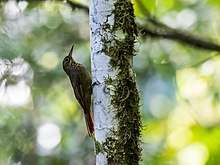Tschudi's woodcreeper
Tschudi's woodcreeper (Xiphorhynchus ocellatus chunchotambo) is a passerine bird native to South America. It belongs to the genus Xiphorhynchus in the woodcreeper subfamily, Dendrocolaptinae. It is usually regarded as a subspecies of the ocellated woodcreeper (X. ocellatus). It is named after Johann Jakob von Tschudi, the Swiss explorer and naturalist who first described the bird.
| Tschudi's woodcreeper | |
|---|---|
 | |
| Scientific classification | |
| Kingdom: | Animalia |
| Phylum: | Chordata |
| Class: | Aves |
| Order: | Passeriformes |
| Family: | Furnariidae |
| Genus: | Xiphorhynchus |
| Species: | X. ocellatus |
| Subspecies: | X. o. chunchotambo |
| Trinomial name | |
| Xiphorhynchus ocellatus chunchotambo (Tschudi, 1844) | |
| Synonyms | |
|
Xiphorhynchus chunchotambo | |
Taxonomy
It was initially described as a species by Johann Jakob von Tschudi in 1844. He named it Dendrocolaptes Chunchotambo but it was later moved to the genus Xiphorhynchus. It was later lumped into the ocellated woodcreeper (X. ocellatus) but Aleixo (2002) recommended splitting the species based on a study of mitochondrial DNA which showed that the ocellated woodcreeper was more closely related to the chestnut-rumped woodcreeper (X. pardalotus) than to Tschudi's woodcreeper.[1] The South American Committee of the AOU have yet to recognize the split however.
There are two or three subspecies of Tschudi's woodcreeper group: X. o. chunchotambo, X. o. brevirostris and perhaps X. o. napensis.
Description
It is a medium-sized woodcreeper, 20–21 cm in length.[2] The bill is fairly long and slightly curved. The plumage is mostly brown, becoming more rufous on the rump, wings and tail. The bird has a buff throat, buff spots on the crown and breast, fine buff streaks on the back and a black moustachial stripe.[3]
The song is a descending series of staccato notes. It calls include a short descending whistle, a quavering liquid call and a dry rattle.[2]
Distribution and habitat
It is found along the east Andean slope and adjacent Amazonian lowlands from southern Colombia south through Ecuador and Peru to northern Bolivia and far south-western Brazil. X. o. chunchotambo occurs in central Peru, X. o. brevirostris in south-east Peru, northern Bolivia and south-western Brazil, and X. o. napensis in southern Colombia, eastern Ecuador and north-east Peru.[4][5] It is found in humid forests where it forages in the lower and middle storeys of the forest, often in mixed-species feeding flocks.[2][3]
References
- Aleixo, Alexandre (2002) Molecular systematics and the role of the "Várzea"-"Terra-firme" ecotone in the diversification of Xiphorhynchus woodcreepers (Aves: Dendrocolaptidae). Auk, 119 (3): 621-640.
- Schulenberg, Thomas S.; Stotz, Douglas F.; Lane, Daniel F.; O'Neill John P. & Parker, Theodore A. III (2007) Field Guide to the Birds of Peru, Christopher Helm, London. ISBN 978-0-7136-8673-9
- Ridgely, Robert S. & Guy Tudor (1994) The Birds of South America, volume 2: the Suboscine Passerines, University of Texas Press.
- Clements, James F. (2007). The Clements Checklist of Birds of the World. Cornell University Press. ISBN 978-0-8014-4501-9.
- CBRO (2009). (in Portuguese) Lista das Aves do Brasil. Archived 2010-02-22 at the Wayback Machine Version 9/8/2009.